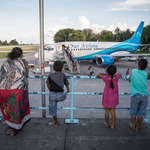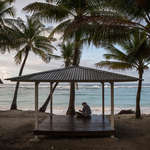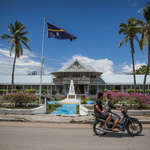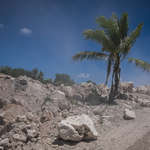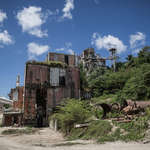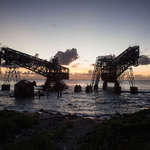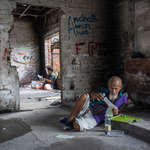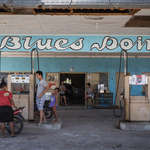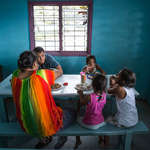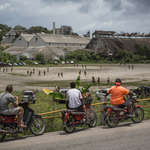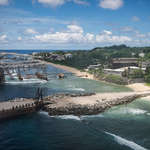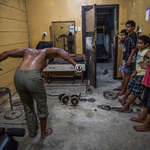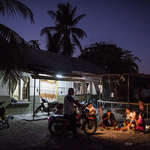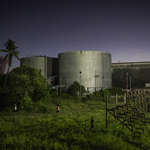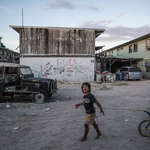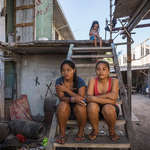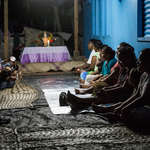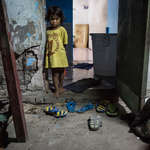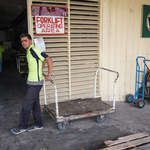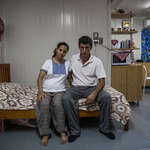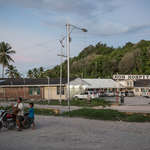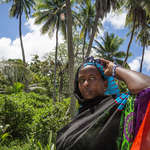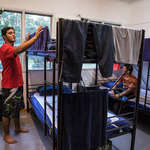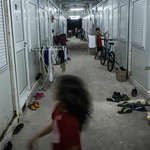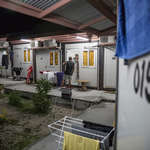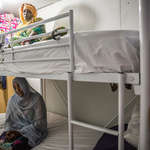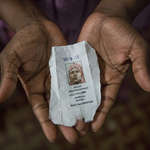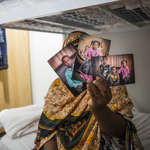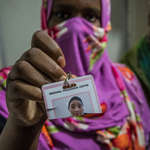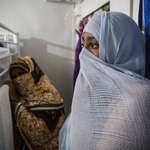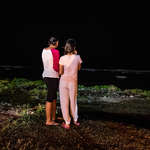
-
The tiny island nation of Nauru, a 21 square kilometre speck of land in the middle of the Pacific Ocean just south of the Equator, today finds itself at the centre of the controversial immigration policy of Australia, its vast and increasingly vigilant neighbour. Following an agreement with the Australian government in 2001, a detention centre built in Nauru to hold illegal migrants who had entered Australia without a visa or were apprehended at sea on their way there.
Since the 1990s, successive Australian governments have been tinkering with the country’s immigration policy, in an attempt to limit the influx of illegal immigrants, or so-called ‘boat people’, who arrive on Australia’s shores and claim asylum. Yet the current policy, sometimes referred to as the ‘Pacific Solution’, of detaining would be immigrants at facilities in neighbouring countries, is a regular source of adverse publicity for Australia.
Nauru was once one of the richest countries in the world with a phosphate industry that accounted for 80% of the national economy until around 2000, when reserves started to run out.
-
After independence in 1968, the government arranged for a part of the phosphate windfall to go to the population, allowing many to live in affluence at home, buy houses abroad and send their children to expensive foreign boarding schools. The depletion of phosphate reserves, however, and the devastation of the island’s environment through wholesale strip mining of its surface, have led to a sudden and catastrophic downturn of fortunes.
For a few years, Nauru tried to sell itself as a tax haven which lead to accusations of illegal money laundering. It was also involved in the sale of passports and diplomatic favours such as the recognition of Abkhazia’s and South Ossetia’s independence in exchange for $ 50 million aid money from Russia in 2008 following its war with Georgia.
Australia’s proposal of making Nauru a de-facto off-shore detention centre in 2001 therefore came as a welcome opportunity to replenish the public purse.The centre, which was initially intended for around 800 people, has now been operating for over 13 years and usually houses over 1,000 inmates, including whole families. Another facility on the island of Manus in Papua New Guinea has been heavily criticised after a number of fatalities in 2014.

-
Over the years, Nauru’s detention centre has been mired in controversy with frequent cases of self harm, suicide attempts and hunger strikes with allegations surfacing in 2014 of child abuse by security staff at the centre and rising concerns about the mental health of detainees. People kept in the Refugee Processing Centre for months after arrival are often kept in tents which have no air-conditioning and get unbearably hot in the tropical climate. Even pregnant women and children are housed in these conditions and there are only eight toilets for a total of 400 people. Detainees are allowed to use the showers for only two or three minutes a day and on some days there’s no direct access to drinking water. Even if an asylum application is successful, former detainees are not completely free on the tiny island and are required to sleep in the community based camps.
-
Only couples with children sleep in the same room. Others are accommodated in separate dorms. The rooms are small and the communal kitchen is mostly overcrowded, so some people have to cook on the floor in their rooms. With a high level of unemployment, it’s almost impossible for foreigners to find work. A few lucky ones help unloading shipping containers for which they are paid around 3 or 4 dollars a day. Competition for the few jobs that are available has led to rising tensions between locals and refugees. In 2013, a riot at the detention centre caused A$ 60 million worth of damage and in 2014, after an Australian government announcement that none of the detainees on Nauru would be resettled in Australia, several detainees sewed their lips shut in protest.
An areal view of the Republic of Nauru, a 21 square kilometre island in the middle of the Pacific Ocean.
People watch the arrival of an Our Airline plane from Brisbane at Nauru International Airport. Our Airline (Nauru Airlines) is the only air company that connects Nauru with the rest of the world and it's an official carrier of the asylum seekers that are detained in the detention centre on the island. Nauru Airlines became a major beneficiary of the Australian-run asylum seeker camps and has gone from flying a single 737 plane to three Boeing jets.
Fetemeh, an Iranian asylum seeker, waits for the bus at the picnic area in Ewa District.
Two men on a motorcycle pass Nauru State House, which was formerly a detention centre for detainees deported from Australia.
A palm tree on the road to the phosphate mine and the Australian Detention Centre. Since the discovery of phosphates in Nauru at the end of the 19th century, 80% of the island's surface has been strip-mined. This has led to extreme environmental degradation and economic collapse in recent years.
An abandoned vehicle stands by the side of a road. Many cars have been abandoned along Nauru's roads and in backyards. With an unemployment rate of around 90%, much of the population is dependent on government handouts which are becoming increasingly unaffordable with the sharp reduction in phosphate output on the island.
Old mining structures in the central part of Nauru Island. Most of them have now been abandoned. Nauru's economy peaked in the early 1980s and has always been almost completely dependent on phosphate.
Daigo, 26, with his 10-months old son Teiwa near an abandoned building in Aiwo district that was used by the mining company.
Abandoned cantilevers that were used to load phosphates from the mining site onto ships. Nauru's economy peaked in the early 1980s and has always been almost completely dependent on phosphate.
People play Bingo in the abandoned building of a Tea Shop in Arijejen District. Bingo is one of the most popular betting games in the country and many Nauruan people spend their evenings and weekends playing and trying to make some money. Majority of Nauru people are unemployed.
Pikato, 58, plays Bingo in the abandoned building of a Tea Shop in Arijejen District.
People at the petrol station 'Blues Point'. Fuel comes to Nauru by ships from Australia and most of the petrol stations in the country are owned by Chinese businesses.
Nauruan family having lunch in Gabab restaurant. Most of the small restaurants in Nauru are owned by people from Honk Kong and the Chinese mainland.
People watch an Australian rules football game in front of the Phosphate processing factory. The sport is very popular in Nauru and, along with weightlifting, is the national sport of the island nation.
An aerial view of the cantilevers that were used to load phosphates from the mining site onto ships.
Children watch Joshua, 16, doing bodybuilding exercises in a small weightlifting gym in Uaboe district. Bodybuilding and weightlifting are very popular among the local youth and many weightlifting champions have won several gold medals in the Commonwealth Games.
Family members gather in front of their house in the evening. A man on a motorcycle shines his light onto the gathered people.
People walk past concrete structures next to an abandoned stadium.
A cemetery along the Island Ring Road in Arijejen District at night time.
Kids play in the Location Block Area. Location Block was a residential area for foreign miners who came to Nauru to work on the phosphite mine. After the closure of the mine in the early 2000s most of the miners left Nauru and the Location Block became a squatters settlement, mostly populated by locals.
Squatters hang out outside their houses in the Location Block Area
A family prepares to travel in the back of a truck in the Location Block
Jonson, 5, lives in hut with his parents in the Location Block
A couple dances near their house while their kids watch in the Location Block Area
Katherine holds her 3 month old son Irais, while playing a card game with her neighbours. Katherine is half Chinese and half Nauruan and lives in the Location Block
Tewira (19, left) and Lusia (14, right) sit on the stairs in front of their family house in the Location Block. Their parents came to Nauru from Tarawa, Kiribati looking for work and a better future for their children. Soon after Nauru started having economical problems in the early 2000s, they and many other people lost their jobs and became squatters in the Location Block Area
A Nauruan family sits outside their house in the Location Block
People pray in the small church in the Location Block
Two-year-old girl Eitsanga stands at the entrance to her parents' house in the Location Block Area. Her parents are unemployed like the majority of the Location Block squatters
A car passes an abandoned house in the Location Block Area
Nauru Australian Immigration Detention Centre (middle).
Asylum seekers from Somalia stand next to a bus stop in Ewa District. The free community buses run around the island every hour to transfer refugees and detention centre workers
A community based camp for asylum seeker families with children in Ijuw District
Rafiq, a refugee from Afghanistan, works in the storage facility of Capelle & Partner, the only department store in Nauru. He was recently released into the community from the Detention Centre and is one of a few refugees who have managed to find a job in a country with a very high level of unemployment
Adnan Shirwani ,36, with his 6-months-pregnant wife Maryam, 33, from the Kurdistan region of Iran. They spent one year in the detention centre and were given refugee status and released to the community based camp in June 2014. Maryam has complications with her pregnancy and Adnan is afraid for the life of his wife and his unborn baby as in Nauru there are only basic health services
People in front of the RON (Republic of Nauru) Hospital, the official health centre that treats asylum seekers who have received an official status in Nauru. There is a lack of health facilities and medicines and the local staff working in the Nauru hospital do not have sufficient qualifications to be registered in developed countries like Australia
Mujtaba Hussein, 21, a Shia Muslim from the Pakistani village of Burke on the border with Afghanistan stands in a container loaded with boxes. He escaped from the Taliban who were killing Shia people in the region and after he was transferred to Nauru, he spent 10 months in the Detention Centre, living in a tent with 20 other people in prison-like conditions. Now he loads containers at one of the local businesses in Nauru. For this job he receives 4 Australian dollars per hour, about 200 dollars per week. He still dreams of going to Australia, where he hopes to receive refugee status
Somalian refugee Mariam (name changed), 26, escaped from Mogadishu in 2013. After she arrived on Christmas Island, an Australian island outpost, by boat she was transferred to the Australian Immigration detention centre on Nauru where she spent about a year living in tents. In the middle of 2014 she was given refugee status in Nauru and was released to live in the community based camp in Anibare District
Fayaz, 18, (left) and Riaz, 18, (right) in their room in Lamen house, a community based house where nine teenage boys (16-18 y.o.) from Pakistan and Afghanistan live after being released from the Nauru Australian Detention Centre
Riaz, 18 sits on his bed bed in Lamen house, a community based house where he was placed by the Australian Immigration with another eight teenage boys. He is a Pakistani Shia muslim from the border area with Afghanistan and had to escape from the Taliban in May 2013. The Taliban were targetting Shia Musilms in his region of Pakistan. After spending seven months in Nauru Detention Centre he was released to the community and given an official refugee status in Nauru
A corridor between the rooms in the community camp for families with children in Ijuw District
Patrick, 32, a Christian from the Iranian region of Awaz sits on his bed in the community based camp in Ijuw District. Patrick, his wife Esther and their 7 year old son left Iran in 2013. After a successful boat trip from Indonesia to Christmas Island, an Australian outpost, they were sent by the Australian Immigration authorities to Nauru, where they spent one year in the detention centre. Patrick says that his son has suicidal thoughts and is afraid of going to school since the local children always fight with him
Anibare community camp for single people or couples without children
Somali refugees Mariam, 26 (top, name changed) and Haha, 24, (below, name changed) escaped from Mogadishu in 2013. They took a risky trip to Christmas Island by boat departing from Indonesia. They were transferred to the detention centre in Nauru by the Australian Immigration authorities, where they spent about a year living intents. In the middle of 2014 they were given refugee status in Nauru and were released to the community camp in Anibare District
A female asylum seeker from Somalia holds an identification document that she used for over a year while she was in the Nauru Australian Immigration Detention Centre.
Sabah, 28, shows photos of her three children who are still in Somali. She hasn’t seen them for three years after she fled from Al-Shabaab jihadis and got separated from her children while escaping
An Iranian woman prepares pastry for pies on the floor of the room where she lives with her husband. Although the camp has a shared community kitchen, it’s always full of people, and very often there is not enough space for everyone to cook
A Somalian woman shows her ID card that she used in the detention centre in Nauru
The entry gate to the Nauru Australian Immigration Detention Centre. Since 2001, Nauru has been at the centre of a controversial policy of the Australian government to send asylum seekers arriving by boat to detention centres outside its territory. The Nauru detention centre has been mired in controversy, with cases of self harm, suicide attempts and hunger strikes common among the hundreds of people who have been processed there. In October 2014 several people sewed their lips shut to protest against an Australian government statement saying that people detained on Nauru would not be resettled in Australia
Somalian women refugees inside their room in the Anibare community based camp for single people or couples without children
Two asylum seekers look at the ocean in front of the entrance to the community based camp for families with children

